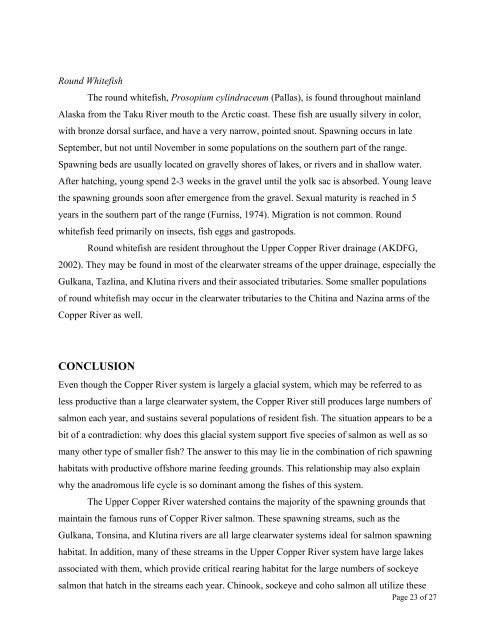Life Histories and Distributions of Copper River Fishes (.pdf)
Life Histories and Distributions of Copper River Fishes (.pdf)
Life Histories and Distributions of Copper River Fishes (.pdf)
You also want an ePaper? Increase the reach of your titles
YUMPU automatically turns print PDFs into web optimized ePapers that Google loves.
Round WhitefishThe round whitefish, Prosopium cylindraceum (Pallas), is found throughout mainl<strong>and</strong>Alaska from the Taku <strong>River</strong> mouth to the Arctic coast. These fish are usually silvery in color,with bronze dorsal surface, <strong>and</strong> have a very narrow, pointed snout. Spawning occurs in lateSeptember, but not until November in some populations on the southern part <strong>of</strong> the range.Spawning beds are usually located on gravelly shores <strong>of</strong> lakes, or rivers <strong>and</strong> in shallow water.After hatching, young spend 2-3 weeks in the gravel until the yolk sac is absorbed. Young leavethe spawning grounds soon after emergence from the gravel. Sexual maturity is reached in 5years in the southern part <strong>of</strong> the range (Furniss, 1974). Migration is not common. Roundwhitefish feed primarily on insects, fish eggs <strong>and</strong> gastropods.Round whitefish are resident throughout the Upper <strong>Copper</strong> <strong>River</strong> drainage (AKDFG,2002). They may be found in most <strong>of</strong> the clearwater streams <strong>of</strong> the upper drainage, especially theGulkana, Tazlina, <strong>and</strong> Klutina rivers <strong>and</strong> their associated tributaries. Some smaller populations<strong>of</strong> round whitefish may occur in the clearwater tributaries to the Chitina <strong>and</strong> Nazina arms <strong>of</strong> the<strong>Copper</strong> <strong>River</strong> as well.CONCLUSIONEven though the <strong>Copper</strong> <strong>River</strong> system is largely a glacial system, which may be referred to asless productive than a large clearwater system, the <strong>Copper</strong> <strong>River</strong> still produces large numbers <strong>of</strong>salmon each year, <strong>and</strong> sustains several populations <strong>of</strong> resident fish. The situation appears to be abit <strong>of</strong> a contradiction: why does this glacial system support five species <strong>of</strong> salmon as well as somany other type <strong>of</strong> smaller fish? The answer to this may lie in the combination <strong>of</strong> rich spawninghabitats with productive <strong>of</strong>fshore marine feeding grounds. This relationship may also explainwhy the anadromous life cycle is so dominant among the fishes <strong>of</strong> this system.The Upper <strong>Copper</strong> <strong>River</strong> watershed contains the majority <strong>of</strong> the spawning grounds thatmaintain the famous runs <strong>of</strong> <strong>Copper</strong> <strong>River</strong> salmon. These spawning streams, such as theGulkana, Tonsina, <strong>and</strong> Klutina rivers are all large clearwater systems ideal for salmon spawninghabitat. In addition, many <strong>of</strong> these streams in the Upper <strong>Copper</strong> <strong>River</strong> system have large lakesassociated with them, which provide critical rearing habitat for the large numbers <strong>of</strong> sockeyesalmon that hatch in the streams each year. Chinook, sockeye <strong>and</strong> coho salmon all utilize thesePage 23 <strong>of</strong> 27
















